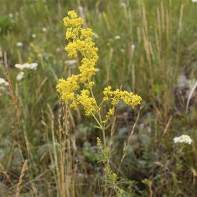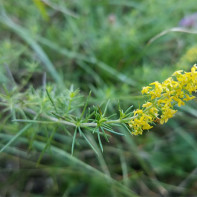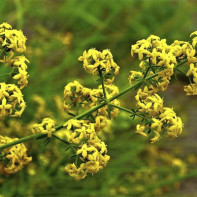Bedstraw: medicinal properties and contraindications
Bedstraw (aka Galium - from the Greek name for milk) is a medicinal plant that grows in Eurasia and North America. In nature, there are several hundred species of this plant, but not all are used in modern herbal medicine, or in traditional folk medicine. There are poisonous varieties that must be handled with particular care.
Chemical composition
The chemical composition of two varieties is best studied - a real bedstraw (aka yellow) and tenacious. Both of them are actively used in folk medicine, and substances valuable for pharmacology are found in the grass, in the stems, and in the flowers, and even in the rhizomes of these plants.
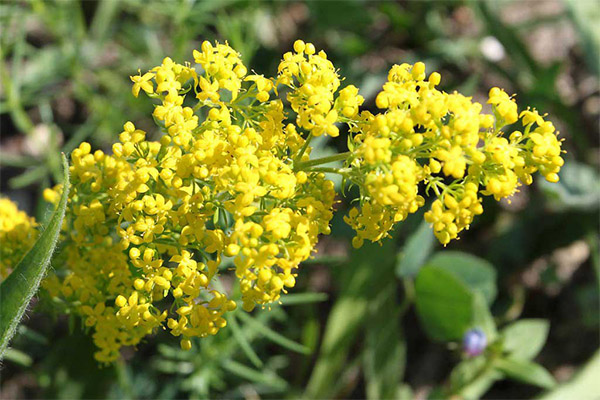
The chemical composition of the bedstraw of the present is well studied, it includes:
- Steroid Saponins. Their function in nature is to protect the plant from pests and diseases. They have antifungal properties, in addition, they are used to obtain hormonal drugs.
- Ascorbic acid (vitamin C), which normalizes the state of blood vessels and the circulatory system as a whole, and also strengthens the immune system.
- Carotene, good for vision.
- Flavonoids with anti-inflammatory and antioxidant properties.
- Various organic acids.
- Tannins and dyes (the name of this plant is associated with the latter - because it emits the same pigment as madder).
- Various trace elements - copper, iron, zinc, even nickel and cobalt and others.
In the flowers and leaves of this variety contains the curing enzyme rennin, thanks to him in ancient times this plant was also used for the production of cheese.
The chemical composition of the sticky bed is generally similar to the previous one. It also contains steroidal saponins, glycosides, flavonoids and coumarins. But, in addition, there is also salicylic acid, which has antiseptic and keratolytic properties. Both ursolic acid and the corresponding aldehyde are contained, which determine the use of the plant for the treatment of urolithiasis. Clinging bedstraw also contains salts of zinc, cobalt, magnesium, nickel, etc.
How it looks and where it grows
Almost all species of this plant are widespread throughout the globe. For example, a bedstraw grows not only in Europe, but also in North Africa. In Asia, it is found in temperate climates almost everywhere, including Turkey, the countries of the Middle and Far East. The plant can be found even in New Zealand (although it was brought there by the colonists), in North America. Basically, bedstraws grow in hay meadows, wheat fields, along roads and on land boundaries, they love fertile soils.
Among the bedstraws, both one-, two-, and perennial plants are found. Rhizomes of all species are thin and highly branched. In some species, they have healing properties.
The stems of this plant are most often thin, in some - creeping. But there are varieties with strong straight stems, for example, northern bedstraw. The leaves of this plant are narrow, saturated green, in some species with serrated edges. The flowers are small, star-shaped, the color of the petals can be very diverse - white, bright yellow, pink. There are varieties, for example, fragrant bedstraw, with a pleasant smell.
Views
There are different types of bedstraws, most of them are found in Russia, Belarus and Ukraine:
- Northern bedstraw. This is a perennial herb, reaching a height of at least 15 cm, and sometimes growing almost up to a meter.A distinctive feature is small narrow leaves with three veins, connected in several pieces. The plant blooms with small flowers, usually a white hue. It mainly grows in forest meadows, loves raw floodplains. And although the bedstraw usually likes fertile soils, this variety can feel great both on rocky soils and in marshy areas. In herbal medicine, mainly flowers and leaves of this variety are used.
- The bedstraw is real. This is a perennial plant with a strong straight stalk reaching a height of about 60–70 cm. Its leaves are spiky, their surface has a pronounced green tint, and from below they are covered with a gray velvety fluff. It is considered a wonderful honey plant. Its bright yellow flowers are connected in fluffy panicles. They actually have a pronounced honey aroma that attracts bees throughout the summer. This variety is most often found in meadows, he loves fertile soils, and in good weather conditions and the absence of obstacles, real plantations can grow there.
- Cleavers. This plant, in fact, is a weed, and it is also unusually resistant to any methods of combating it. Its main feature is the structure of its stems, covered with small cloves, thanks to which it is very firmly attached to the smooth surface of the stalks of bread ears. Its leaves are narrow, small white flowers make up small inflorescences of a semi-umbrella type. In folk medicine, the fresh juice of this plant is often used, it is considered very effective in the treatment of various liver diseases and thyroid dysfunction. And now in herbal medicine are exploring the possibility of its use against malignant tumors. The ingredients that make up the herbs and flowers of this plant also provide it with the properties of a diuretic and antioxidant. Ointments, decoctions and infusions based on this variety have the properties of healing wounds, which allows them to be used for various dermatological disorders.
- The bedstraw is fragrant. This plant variety is also perennial. Its stems reach a height of up to 65 cm. Among all its relatives, the fragrant bedstraw is considered the most beautiful. Inflorescences are several semi-umbrellas at once, consisting of many small flowers with a pleasant smell. The fragrant bedstraw begins to bloom earlier than other species, back in April. And its flowering continues only until the beginning of summer. Most often it is found in the Crimea, the Caucasus, and Central Asia, although it can be found in other regions of Russia.
- Common bedstraw. This is one of the highest varieties of this plant. In height, it can be at least 85 cm. Its stalk is strong, faceted in shape, with little branching. Leaflets are small and narrow. Above, they are pubescent weaker, from below - stronger. The flowers of this variety are soft golden. This plant blooms at the end of the first summer month and blooms before the start of autumn. It occurs mainly in dry meadows and small slopes. A distinctive feature of this variety is the presence in its chemical composition of silicic acid and a large amount of essential oils.
- Bedstraw is soft. Its distinguishing feature is the somewhat unusual tetrahedral shape of a smooth stem. It grows small oblong leaflets with small spines at the ends. The flowers are small, with white petals, they are collected in inflorescences, forming quite large panicles at the ends of the stems. This type of bedstraw blooms relatively briefly, at the end of June and the first half of July. It is found along roads and in meadows. In traditional recipes of Siberian medicine it is mainly used to eliminate heart rhythm disturbances.
The therapeutic effect of some varieties of bedstraws is considered poorly understood. However, almost all of these species are promising raw materials for the pharmaceutical industry.
Collection and storage
Since phytotherapy today mainly uses two types of bedstraws, one should consider the features of their collection and storage.
As for the bedstraw of the present, in this case the medicinal raw material is all parts of the plant - rhizomes, stems, leaves and flowers. It is better to harvest it during flowering. It is recommended that the collected raw materials be dried naturally in the open air, but preferably in the shade. You can dry in a warm attic, provided that it will be well ventilated. For drying, the stems, leaves and flowers are laid out on cotton cloth or paper (however, you cannot take a newspaper, because then the raw materials will absorb harmful printing ink). The grass and flowers are laid out in a thin layer, periodically you need to ted them in order to dry better.
Rhizomes of bedstraws are recommended to be harvested throughout the summer, regardless of the flowering period. Dry them in the fresh air. All types of raw materials are recommended to be stored either in linen bags, or in paper bags, or in tightly closed glass jars. But all this can only be kept in closed cabinets so that they do not get sunlight. Shelf life is three years.
In the case of tenacious, only grass is harvested during flowering. Rhizomes are used less often, but if they are nevertheless harvested, then in the fall. Dried raw materials in the shade or in dryers designed for vegetables and fruits, and the roots must first be chopped.
Medicinal properties of the herb
Not all medicinal properties of the bedstraw, which were attributed to him in antiquity, are proven today. However, many of its characteristics have been confirmed by scientific research. Today it is believed that a real bedstraw has:

- The anti-inflammatory effect that flavonoids provide.
- Estrogenic effect (due to steroidal saponins, which have properties similar to the characteristics of female hormones).
- Weak antiseptic effect, thanks to all the same saponins, as well as organic acids.
- Bile and diuretic properties.
- Wound healing effect.
- General strengthening effect due to the vitamins and minerals listed above.
In addition, he has sedative and hemostatic properties. It can also be used as a natural laxative.
As for the saber, it has:
- Antitumor effect. There are studies proving that its extract destroys the cells of malignant neoplasms of the mammary gland, but does not affect healthy tissues. This action is provided by diosmethine - a substance that is contained in the grass of the stalk.
- Antiproliferative properties, which also allows you to fight tumors.
- Antifungal activity - due to the content of saponins, which in natural conditions are needed in order to protect the plant from similar microorganisms.
In folk medicine, the antipyretic properties of a tenacious tenor are also known. In Eastern Siberia, decoctions of its herbs were used in antiquity as an antiepileptic. However, at present, these plant properties are still not well understood.
Application in traditional medicine
In traditional and modern herbal medicine, remedies based on a real or tenacious bedstraw are used for such diseases:
- Angina, bronchitis, various diseases of the respiratory tract, up to pneumonia. In such cases, an infusion of bedstraw herbs is used - 2 teaspoons of dried and chopped leaves and herbs, pour a glass of boiling water, then insist for 50-60 minutes, filter. Divide the resulting amount into three equal servings and drink three times a day, regardless of food intake.
- Diseases of the liver, including inflammatory ones. They are treated with broth - 1 tbsp. teaspoon of dry raw materials brew a glass of boiling water and heat over low heat for 5 minutes. Then cool the product to an acceptable temperature, strain and take in equal portions three times a day.
- Erectile disfunction. It is recommended to take fresh juice of the aerial parts of the plant - 2 tbsp. tablespoons at least three times a day, the duration of the course is at least a month.
- Angina pectoris. It is necessary to prepare a weak infusion of the rhizome of a common bedstraw - 20 g of dry plant material per 0.5 l of boiling water.
- Pathologies of the female reproductive system, including fibromyoma, endometritis, amenorrhea (painful menstruation). To do this, brew the infusion as described above and take three times a day. But it is possible to treat this disease and inflammatory diseases of the pelvic organs. In this case, 4 tbsp. tablespoons of dry plant material pour 0.4 liters of boiling water, insist in a thermos for 4 hours, then strain and add to the bath water.
- Cervical erosion. A decoction of grass, leaves and flowers of a bedstraw is recommended for vaginal douching.
- Breast disease. You can take an infusion of grass (2 teaspoons of raw materials per glass of boiling water) or apply a mass of fresh leaves of the plant, crushed to a mushy state, to the problem area.
- Skin diseases like eczema, some types of dermatitis, boils, abscesses, and even carcinomas. In such cases, the affected skin should be lubricated with freshly squeezed grass juice. However, some modern herbalists advise using for this purpose a powder from the dried flowers of a yellow bedstraw. From it you need to make an ointment (adding vaseline or unsalted butter) for inflamed and rash-affected areas.
- Diabetes. It is recommended to drink freshly squeezed juice of the aerial parts of the plant - 2 tbsp. spoons after the main meals, and in no case can you add honey, as it will reduce the effectiveness of the drug.
In addition, different types of preparations from this herb can be used for other diseases. For example, powder from dried grass of bedstraw is considered an effective remedy for dysentery, since it has antiseptic properties.
Decoctions and different concentrations of grass infusions are prescribed in the treatment of cut wounds and suppurations, as well as serious burns. Since they have mild analgesic properties in combination with anti-inflammatory effects, they are used as compresses in the treatment of gout.
The presence of ursolic acid in the structure of the sticky bed allows you to use its infusion in the treatment of jade, diseases of the genitourinary system and biliary tract.
Charges containing bedstraws
This plant is used not only as an independent medicine. It is part of various treatment fees. All of them are prepared the same way - 1 tbsp. spoon of a mixture of dry chopped herbs to 370 ml of boiling water. All this is insisted for three hours, filtered and taken in different portions three times a day.
For the destruction of oxalate and phosphate stones in the bladder, a collection is made on the basis of bedding rhizomes, taken in equal proportions with dyeing madder, dill seeds, mint and St. John's wort leaves, barberry berries. This tool is taken for four months, then take a break, undergo a re-examination. If necessary, the course can be repeated, but only after consulting a doctor.
To destroy stones in the gallbladder, a collection is prepared based on the grass of the bedstraw, which is mixed in equal proportions with the grass of milk thistle, horsetail, shepherd’s bag, with flowers of a pharmacy chamomile, corn stigmas and leek root.This infusion is also taken for four months after consulting a doctor.
Supplementation can even fight against serious vascular diseases such as hemorrhagic vasculitis. They can also be effective for cholecystitis outside the acute stage, glomerulonephritis, and other diseases.
Although bedstraw itself has laxative properties, in combination with other herbs, it can, on the contrary, be used as a remedy for diarrhea. In this case, a collection is prepared from the grass of the bedstraw, shepherd’s bag, thyme, and wheatgrass rhizome. But you can’t take such a drug for a long time, especially if the cause of diarrhea is not established. If this is a bacterial infection, then the antiseptic and antifungal activity of the bedstraw does not replace taking antibiotics!
Types of healing compounds
Based on the herbs of the bedstraw, various types of medicinal products are made. For external use, three options are used:
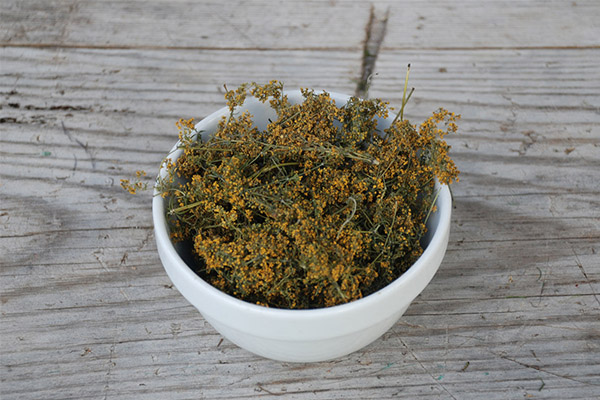
- Powder. It is a dried and crushed raw material obtained from the aerial parts, that is, grass, flowers and leaves. It is used to treat diseases like dermatitis.
- Gruel for lotions and compresses, which is made from shredded fresh grass and flowers. It is used as lotions for any skin diseases, but is most effective for abscesses and suppuration.
- Ointment. It is prepared on the basis of fresh grass pulverized into gruel or dried raw materials. In the first case, it is ground in a mortar with fresh butter. In the second - you can use petroleum jelly or another neutral fatty base. Such remedies are effective for any dermatological problems.
For internal use, take infusions, decoctions, juice and alcohol tincture. Less commonly used is tea from the grass of the bedstraw.
Tincture
Tincture of bedstraw can be water or alcohol. In the first case, 1 tbsp. a spoonful of raw materials is poured into a glass of boiling water and insisted in a thermos for several hours, and then filtered. The concentration of nutrients can be controlled by adding more or less plant material.
For alcohol tincture take ethyl alcohol or vodka. At 2 tbsp. tablespoons of plant materials use 0.4-0.5 liters of alcohol base. Insist the product for at least 4 weeks, all this time the container should be in a dark place, periodically it needs to be removed and shaken.
Tea
You can brew this product both from grass and leaves, and from the flowers of the bedstraw. For 1 teaspoon, take a glass of boiling water - the concentration is lower than that of the infusion. To improve the taste, you can add a little honey to the drink.
Contraindications
This herb does not have many contraindications; the main one is individual intolerance and allergic reactions. However, it should be remembered that the bedstraw is a slightly poisonous plant. Its decoctions, infusions, and even more concentrated juice should not be given to children, it is contraindicated during pregnancy and lactation. However, young mothers should not take it also because it contains hormone-like substances that can affect the course of pregnancy.
Due to the strong diuretic effect, preparations based on this plant should be taken with caution in diabetes.
Interesting Facts
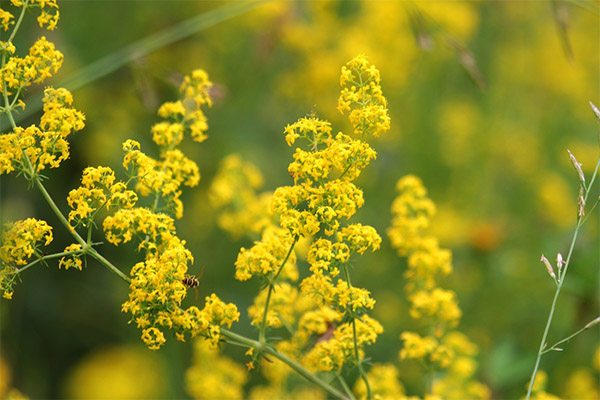
- Bedstraw is a plant widely known since ancient times. Even in antiquity it was known that it has coloring properties, as well as the ability to curd cheese. However, in England, bedstraw was also used because its smell frightened off fleas. In those days, mattresses were stuffed with herbs, and this plant was necessarily one of them. Therefore, the old British name for bedstraw sounds like Our Lady’s Bedstraw (which can be translated as “our lady’s straw bed”).
- Bedstraw has coloring properties. It was used to give the fabrics a yellow tint.And he was part of the hair dye - cheap and affordable. Therefore, another English name for this herb is Maid’s Hair (it translates as “maid hair”).
- In ancient herbalists it is also written that the bedstraw gives strength to tired travelers, and its fresh juice can be used against any skin rashes.
«Important: all information on the site is provided exclusively in fact-finding purposes. Before applying any recommendations, consult with a profile specialist. Neither the editors nor the authors are liable for any possible harm caused materials. "


